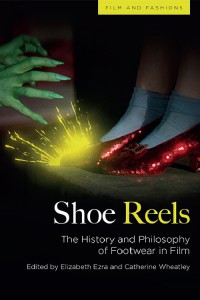Shoe Reels
The History and Philosophy of Footwear in Film
Edited by Elizabeth Ezra and Catherine Wheatley


Average rating: ![]()
| 0 | rating | |
| 0 | rating | |
| 0 | rating | |
| 0 | rating |
Your rating: -
Book Presentation:
Examines the enduring significance of shoes to the cinema through a variety of theoretical approaches
• Traces the relationship between one particular object (shoes) and film as a medium in order to reveal the significance of material things to cinema, thematically, formally and philosophically
• Reveals the political, cultural and economic power of film through its deployment of the iconography of shoes
• Asks if, and how, film "uses" shoes differently from other art forms, and if so what this difference reveals about the medium, and about our current age of art
• Offers insights into debates around stardom; costume; gender; material objects and trauma; objects and the history of cinema; consumerism and advertising
In his famous interpretation of Vincent Van Gogh’s painting A Pair of Peasant’s Shoes (1886), Heidegger argues that shoes tell us all we need to know about the world of the person who walks in them. In the case of Van Gogh’s painting, we learn this not through a description of the pair of shoes, nor by a report on how to make shoes, but by looking at the shoes. Heidegger thus gestures towards the power of the visual arts to show us human truths through images of footwear and the feet they conceal or reveal, a power that finds its fullest expression in the cinema. From Chaplin’s meal of boots (The Gold Rush, 1925), through Powell and Pressburger’s Red Shoes (1948) and Dorothy’s ruby slippers (The Wizard of Oz, 1939), to Julia Roberts’ pvc thigh-highs (Pretty Woman, 1990), Marty McFly’s power-lacing Nikes (Back to the Future, 1985) and the slim, spike-heeled stiletto that graces the poster for The Devil Wears Prada (2006), shoes are not only some of the cinema’s most enduring icons; they also serve as characterisations, plot devices, soundtracks, metaphors and philosophical touchpoints. This book anaylses their significnace through a range of approaches drawn from the fields of Film Studies, Philosophy, Cultural History, Fashion, Cultural Studies and Politics.
About the authors:
Professor Elizabeth Ezra is Professor of Cinema and Culture at the University of Stirling.King’s College London
Press Reviews:
As the word count of this review illustrates, Ezra and Wheatley’s abundant and compelling text brings together studies of dress, film, philosophy, fact and fiction. Suitable for a range of audiences, from the purely interested, to the academic scholar, this rich anthology will be an indispensable tool in explor-ing the widening parameters of cinematic studies.– Dr Cheryl Roberts, Royal College of Art, Studies in Costume & Performance
As the word count of this review illustrates, Ezra and Wheatley’s abundant and compelling text brings together studies of dress, film, philosophy, fact and fiction. Suitable for a range of audiences, from the purely interested, to the academic scholar, this rich anthology will be an indispensable tool in explor-ing the widening parameters of cinematic studies.– Dr Cheryl Roberts, Royal College of Art, London, Studies in Costume & PerformanceThis is a fascinating, almost microscopic, take on the materiality of things in cinema, which is all the more unique for considering the cultural significance of shoes (as well as their lack) on screen.– Shelley Cobb, University of SouthamptonThis is a fascinating, almost microscopic, take on the materiality of things in cinema, which is all the more unique for considering the cultural significance of shoes (as well as their lack) on screen.– Shelley Cobb, University of Southampton
See the publisher website: Edinburgh University Press
> From the same authors:
Je t'aime... moi non plus (2010)
Franco-British Cinematic Relations
Dir. Lucy Mazdon and Catherine Wheatley
> On a related topic:
Designing Hollywood (2023)
Studio Wardrobe in the Golden Age
Creating the Illusion (2015)
A Fashionable History of Hollywood Costume Designers
by Jay Jorgensen and Donald L. Scoggins